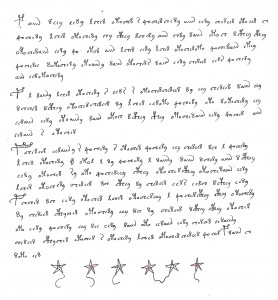A few days ago, I was emailed by Gerry Scott from Cornell who recently, with the help of a friend, started putting together his own Wiki (a set of webpages editable by anybody) to try to give structure to the seething mass / wobbly jelly that is Voynich Manuscript research. Here’s a direct link to what they’ve done so far.
One of the nice things about this is that Gerry has tried to take my (many) criticisms of the Wikipedia page on board, and so has consciously…
“tried to segregate facts and speculation. The wiki includes separate sections for textual, linguistic, provenience [sic], and art-historical research, and uses distinct “theory” and “fact” subsections within each section.“
He’s aiming high, which is admirable: but it has to be pointed out that the challenge involved – basically, building an online ‘Encyclopaedia Voynichiana’ – is nothing short of gargantuan. It’s at least a decade’s work, and with Wilfrid Voynich’s 2012 centenary looming, we only really have a year before the next tsunami of documentaries hits our virtual shores.
Personally, I think there’s a better way: fix the Wikipedia entry. It’s the #1 resource served up by just about every Voynich-related web-search, as well as the #1 link given by just about every inane half-troll writing up their own gee-whiz account of the VMs: whether we like it or not, it’s going to remain the public face of Voynichology for quite some time yet.
The problem is that it’s, well, pants – it’s overlong, overcondensed, underreadable, and a reader coming to the topic fresh doesn’t really leave the page any the wiser. Structurally, the page’s core problem is that it has no clear distinction between facts, evidence, observations, hypotheses and suppositions: at the same time, over time its text has expanded to about 55K, which is just about the right point to start splitting it up into smaller, more useful pages. But how should it be split?
Personally, I think the content has been squeezed out by a barrage of meta-content – most of the text now seems to be taken up with theories about theories. Honestly: the moment any Wikipedia page fixates so heavily on theories that the thing itself gets lost, something has gone badly wrong.
But what to replace it with? I think there should be a guiding strategic principle in play: no theories on the root page, just facts and evidence. Furthermore, I’d split it up so that Voynich theories (Bacon, Filarete, Leonardo, Ascham, Dee/Kelley and, errrm, Bacon again, etc), Voynich meta-theories (hoax, glossolalia, exotic language, artificial language, hybrid language, shorthand, ciphers, etc), and Voynich history/provenance each have their own page. Which is not to say that those topics are not interesting in their own right: but rather that they’re secondary topics, and not essential to building up a primary understanding of the object itself.
At this point, some might say… “but take away all that stuff, and what would be left?” Actually, I think a surprisingly large amount would remain, pretty much all of which is what people new to the VMs primarily want to know about.
The Wikipedia page is the shopfront to our community and our research, and it’s not serving us well… so it’s time to fix it. If you would like to have a say in what happens next, please join in the debate on the Voynich Wikipedia talk page, or just leave a comment here.



